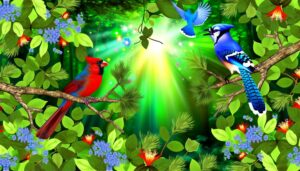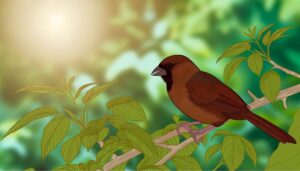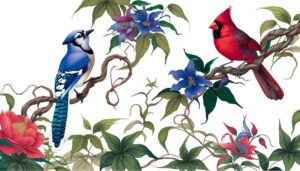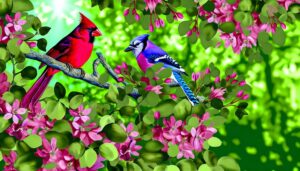Why Are There Birdwatchers Curious About a Blue Cardinal?
The existence of a genuine blue cardinal is not supported by scientific evidence. Cardinals are known for their distinct red coloration, which comes from carotenoid pigments in their diet.
Blue coloration in birds typically arises from structural colors caused by light refraction, not from pigments. Reports of blue cardinals are often due to misidentifications, such as confusing them with Indigo Buntings or Blue Grosbeaks.
Although genetic variations can lead to unexpected colorations, rigorous scientific validation is necessary. To further understand the principles behind avian coloration and the reasons behind these sightings, one must explore the science of bird pigmentation and structure.
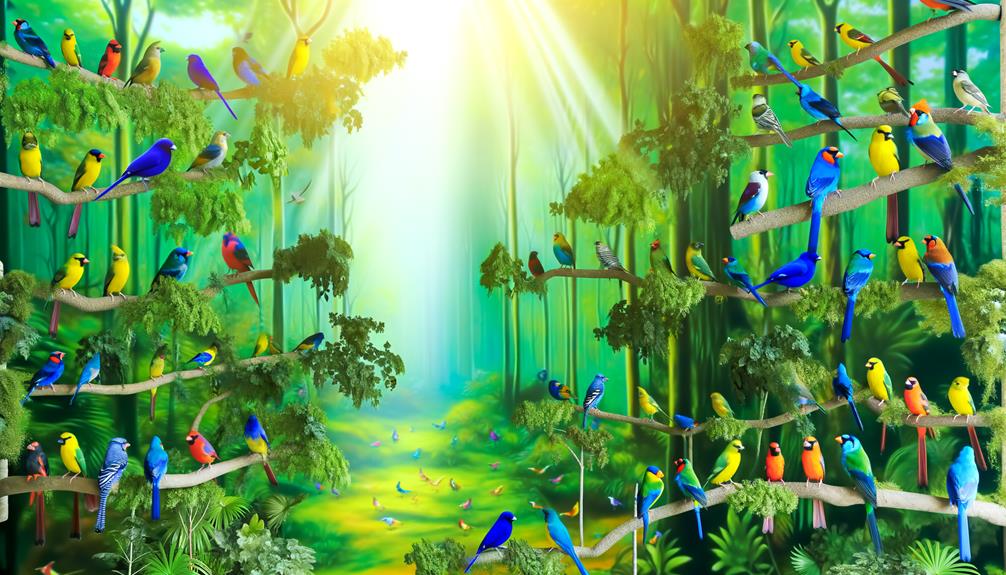
Key Takeaways
- Blue cardinals have not been scientifically validated despite anecdotal sightings.
- Misidentifications often occur with similar species like Indigo Buntings and Blue Grosbeaks.
- Carotenoid pigments responsible for cardinal red coloration do not produce blue hues.
- Structural coloration, not present in cardinals, creates blue in birds like Blue Jays.
- Genetic factors and feather microstructure determine bird coloration, limiting blue cardinal feasibility.
The Cardinal's Signature Red
The vibrant red plumage of the northern cardinal (Cardinalis cardinalis) is primarily due to the presence of carotenoid pigments, which the birds obtain through their diet. These pigments are metabolized and deposited in the feathers, resulting in their striking coloration.
Carotenoids are derived from consuming fruits, seeds, and insects, making diet a critical factor in maintaining their vivid appearance. The intensity of the red coloration can also serve as an indicator of the bird's health and fitness, as only individuals with access to a nutrient-rich diet can achieve such brilliance.
This reliance on dietary carotenoids for color expression underscores the interconnectedness of ecosystem health and the visual signals used in avian mate selection and territorial displays.
Bird Genetics and Color Variations
Genetic variations play an essential role in determining the range of colors exhibited by bird species, including cardinals. These variations result from different combinations of pigments and structural coloration mechanisms. Melanin and carotenoids are primary pigments influencing colors, while structural colors arise from light refraction through microscopic feather structures.
| Pigment Type | Description | Example Coloration |
|---|---|---|
| Melanin | Produces blacks and browns | Blackbird, Sparrow |
| Carotenoids | Derives from diet, yields reds and yellows | Cardinal, Goldfinch |
| Porphyrins | Rare, gives greens and reds | Turacos, Owls |
| Psittacofulvins | Unique to parrots, adds red and yellow | Parrots |
| Structural | Microscopically based, creates blues | Blue Jay, Peacock |
Understanding these genetic mechanisms offers insight into the potential for color variations, including the speculative existence of blue cardinals.
Reports of Blue Cardinals
Anecdotal sightings and photographic claims of blue cardinals have sparked curiosity and debate within the ornithological community. These reports, although intriguing, require rigorous scientific scrutiny to authenticate.
Documented sightings often share certain commonalities:
- Geographical Distribution: Reports mainly emerge from North America, especially in regions recognized for their rich avian biodiversity.
- Temporal Patterns: Sightings typically occur during the spring and summer months, aligning with the breeding season of the Northern Cardinal (Cardinalis cardinalis).
- Visual Evidence: Photographs and videos, while compelling, often suffer from limitations such as poor resolution and lack of corroborating data.
These elements necessitate a meticulous approach to validate the existence of a blue variant of the cardinal, moving beyond mere anecdotal evidence.
Misidentifications and Similar Species
Despite the intriguing nature of these reports, a significant number of blue cardinal sightings can be attributed to misidentifications and confusion with similar species. The Indigo Bunting (Passerina cyanea) and Blue Grosbeak (Passerina caerulea) are prime examples, both possessing vibrant blue plumage that can easily lead to erroneous identification.
Additionally, lighting conditions and individual bird variations play a role in these visual misinterpretations. Observers might also mistake molting cardinals, which temporarily exhibit atypical coloration, for a different species. Moreover, aberrant plumage mutations, though rare, can result in unusual colorations.
The Science Behind Bird Coloration
The vibrant coloration of bird feathers is primarily driven by the interplay of pigments and structural colors, which result from complex biochemical and physical processes. Pigments such as melanins, carotenoids, and porphyrins absorb specific wavelengths of light, giving feathers their intrinsic colors.
Structural colors arise from the microscopic arrangement of feather barbules, which manipulate light through scattering and interference. This combination of pigmentation and structural mechanisms creates the rich diversity of hues seen in avian species.
Key factors influencing bird coloration include:
- Pigments: Melanins produce blacks and browns, carotenoids yield reds and yellows, and porphyrins generate greens and reds.
- Structural Colors: Physical arrangements cause iridescent blues and greens through light scattering.
- Genetic and Environmental Factors: These affect pigment deposition and feather microstructure, ultimately influencing coloration.
Conclusion
The existence of a true blue cardinal remains unsubstantiated, with most reports likely resulting from misidentifications of similar species.
Genetic mutations can cause color variations, but no verified blue cardinal has been documented.
Surprisingly, only about 1 in every 180,000 northern cardinals exhibit rare color mutations, such as yellow or partial albinism. This statistic underscores the rarity of significant coloration changes, reinforcing the improbability of a blue cardinal emerging naturally.
The science behind avian coloration continues to intrigue ornithologists and geneticists alike.


